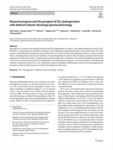

PARTNER
검증된 파트너 제휴사 자료
Research progress and the prospect of CO2 hydrogenation with dielectric barrier discharge plasma technology
15 페이지
최초등록일 2023.12.18
최종저작일
2023.06

-
 * 본 문서는 배포용으로 복사 및 편집이 불가합니다.
* 본 문서는 배포용으로 복사 및 편집이 불가합니다.
미리보기
서지정보
· 발행기관 : 한국탄소학회
· 수록지 정보 : Carbon letters / 33권 / 4호
· 저자명 : Ziyi Zhang, Honglei Ding, Qi Zhou, Weiguo Pan, Kaina Qiu, Xiaotian Mu, Junchi Ma, Kai Zhang, Yuetong Zhao
목차
Research progress and the prospect of CO2 hydrogenation with dielectric barrier discharge plasma technology
Abstract
1 Introduction
2 Reaction mechanism of DBD plasma catalysis
3 Effects and optimizations
3.1 Packing materials
3.2 Reaction parameters of DBD plasm system
3.2.1 Discharge power
3.2.2 Discharge frequency
3.2.3 Discharge length
3.2.4 Feed flow rate
3.2.5 Discharge gap
3.3 Optimization of DBD system
4 CO2 hydrogenation to methane
4.1 Ruthenium-based catalyst
4.2 Nickel-based catalyst
4.3 Metal–organic framework materials
5 CO2 hydrogenation to methanol
5.1 Photocatalysis
5.2 Electrocatalysis
5.3 Plasma catalysis
6 Conclusion
Acknowledgements
References영어초록
In recent years, people are increasingly interested in CO2 hydrogenation to produce value-added chemicals and fuels ( CH4, CH3OH, etc.). In the quest for an efficient treatment in CO2 methanation and methanolization, several technologies have been practiced, and DBD plasma technology gain attention due to its easily handling, mild operating conditions, strong activation ability, and high product selectivity. In addition, its reaction mechanism and the effect of packing materials and reaction parameters are still controversial. To address these problems efficiently, a summary of the reaction mechanism is presented. A discussion on plasma-catalyzed CO2 hydrogenation including packing materials, reaction parameters, and optimizing methods is addressed. In this review, the overall status and recent findings in DBD plasma-catalyzed CO2 hydrogenation are presented, and the possible directions of future development are discussed.참고자료
· 없음태그
-
자료후기
-
자주묻는질문의 답변을 확인해 주세요

꼭 알아주세요
-
본 학술논문은 (주)코리아스칼라와 각 학회간에 저작권계약이 체결된 것으로 AgentSoft가 제공 하고 있습니다.
본 저작물을 불법적으로 이용시는 법적인 제재가 가해질 수 있습니다. -
해피캠퍼스는 구매자와 판매자 모두가 만족하는 서비스가 되도록 노력하고 있으며, 아래의 4가지 자료환불 조건을 꼭 확인해주시기 바랍니다.
파일오류 중복자료 저작권 없음 설명과 실제 내용 불일치 파일의 다운로드가 제대로 되지 않거나 파일형식에 맞는 프로그램으로 정상 작동하지 않는 경우 다른 자료와 70% 이상 내용이 일치하는 경우 (중복임을 확인할 수 있는 근거 필요함) 인터넷의 다른 사이트, 연구기관, 학교, 서적 등의 자료를 도용한 경우 자료의 설명과 실제 자료의 내용이 일치하지 않는 경우
“Carbon letters”의 다른 논문도 확인해 보세요!
-
A review of carbon‑based materials and their coating techniques for bi.. 18 페이지
-
Performance of CNT‑CNP aerogel as electrode in capacitive deionization.. 11 페이지
-
Oxidation behaviour and residual mechanical properties of carbon/ carb.. 12 페이지
-
Synthesis of carbon materials with extremely high pyridinic‑nitrogen c.. 23 페이지
-
Coffee grounds derived sulfur and nitrogen dual‑doped porous carbon fo.. 14 페이지
문서 초안을 생성해주는 EasyAI

